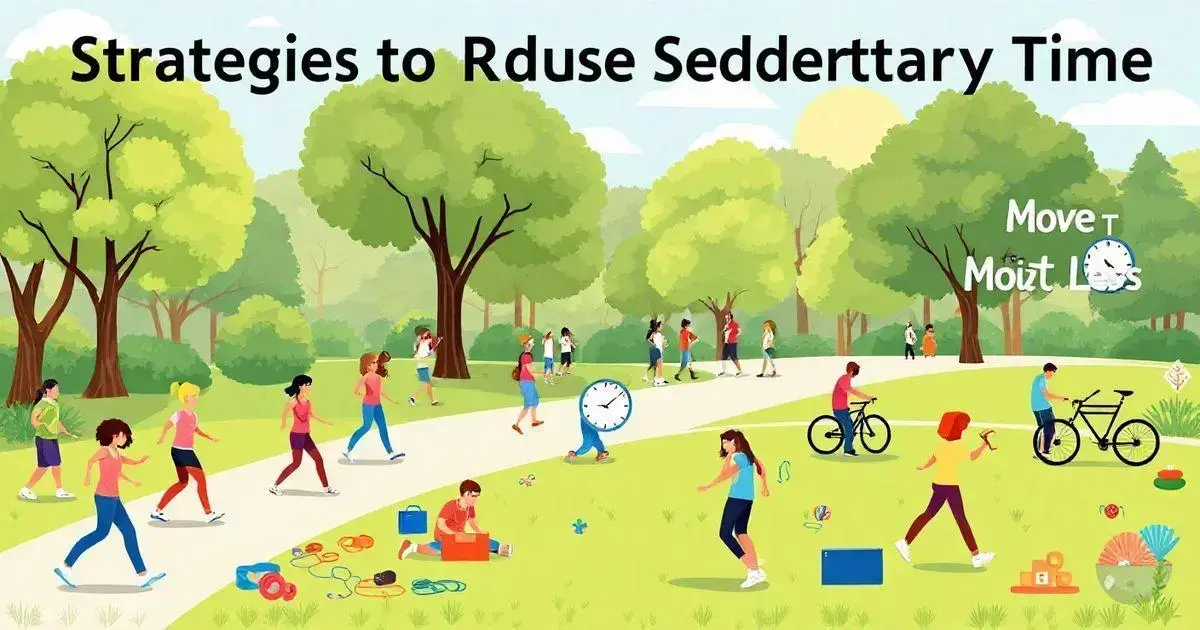What Is a Short Term Consequence of a Sedentary Lifestyle? One of the immediate effects of inactivity is a noticeable dip in energy levels. People who spend long hours sitting can feel fatigued, less motivated, and find it harder to stay productive.
In addition to this, muscle strength and flexibility can begin to decline relatively quickly. Even short periods of reduced movement can impact how we feel physically, leading to discomfort and reduced mobility.
If you’ve been feeling more sluggish lately or noticing some aches and pains, these could be signs that your sedentary habits are taking a toll. Keep reading to discover how simple changes can make a big difference.
Understanding Sedentary Lifestyle
Understanding a sedentary lifestyle is essential as it affects many individuals in today’s fast-paced world. This lifestyle is characterized by prolonged periods of inactivity, often resulting from desk jobs, excessive screen time, or even leisurely activities that do not require physical movement.
What Is a Short Term Consequence of a Sedentary Lifestyle? It can lead to muscle atrophy, weakened bones, and a range of other health concerns.
Research shows that many people spend more than half their day in a sedentary state, which is concerning due to its health implications. What Is a Short Term Consequence of a Sedentary Lifestyle? One of the immediate effects is discomfort from poor posture and tension in the muscles.
One major aspect of a sedentary lifestyle is that it can lead to muscle atrophy and weakened bones over time. Regular movement is vital for maintaining muscle strength and bone density, as physical activity stimulates the bone-building process. Additionally, spending too much time sitting can lead to postural problems and associated discomfort.
It’s also important to note the psychological effects. Lack of physical activity can contribute to feelings of stress and anxiety, as exercise plays a crucial role in the release of endorphins, which help enhance mood. Engaging in physical activities can lead to improved mental clarity and emotional stability.
Furthermore, as people consistently lead a sedentary lifestyle, they may experience a decrease in energy levels and overall productivity. Simple changes, such as taking breaks to walk around or stretching throughout the day, can be beneficial. Understanding these aspects of a sedentary lifestyle is the first step toward making healthier choices and incorporating more activity into daily routines.
Physical Health Risks

The physical health risks associated with a sedentary lifestyle are numerous and can affect individuals of all ages. One of the most concerning outcomes is the increased risk of obesity. When people engage in minimal physical activity, they burn fewer calories, leading to weight gain over time. Excess weight can contribute to further health issues, including diabetes and heart disease.
Another significant risk is the impact on cardiovascular health. Prolonged inactivity can lead to high blood pressure and elevated cholesterol levels, which are risk factors for heart disease. A study found that individuals who sit for most of the day have a higher chance of developing cardiovascular issues compared to those who engage in regular exercise.
Furthermore, a sedentary lifestyle can lead to muscle weakness and decreased flexibility. As the body remains inactive, muscle strength diminishes, leading to an increased risk of injuries even in everyday tasks. Joint issues may also arise as the lack of movement may cause stiffness and pain.
In addition to these physical health risks, a sedentary lifestyle can play a role in chronic conditions such as osteoporosis and certain cancers. Research shows that individuals who sit for longer periods have a higher incidence of such diseases, underlining the importance of remaining active.
Mental Health Impacts
The mental health impacts of a sedentary lifestyle are profound and can significantly affect one’s quality of life. What Is a Short Term Consequence of a Sedentary Lifestyle? When individuals spend long periods sitting or inactive, they may experience heightened feelings of anxiety and depression.
Research indicates that physical activity increases the production of endorphins, often called “feel-good hormones,” which help in managing stress and uplifting mood. What Is a Short Term Consequence of a Sedentary Lifestyle? A lack of movement can lead to feelings of fatigue and lethargy.
Moreover, a lack of movement can lead to feelings of fatigue and lethargy. When the body is not active, energy levels tend to decrease, leading individuals to feel sluggish and less motivated to engage in tasks. This cycle can further contribute to a sense of dissatisfaction with life. Social interactions can also decline due to a sedentary lifestyle.
When the body is not active, energy levels tend to decrease, leading individuals to feel sluggish and less motivated to engage in tasks. This cycle can further contribute to a sense of dissatisfaction with life.
Social interactions can also decline due to a sedentary lifestyle. Often, sitting for long periods may lead to isolation, as individuals miss out on social activities that involve physical movement, making them feel disconnected from friends and family.
Additionally, insufficient physical activity has been linked to cognitive decline. Research shows that exercise stimulates blood flow to the brain, which is crucial for maintaining cognitive functions and overall brain health.
Without regular movement, individuals may not only experience memory issues but also decreased focus and attention spans.
Effect on Sleep Patterns

The effect of a sedentary lifestyle on sleep patterns is significant and can lead to various disturbances. What Is a Short Term Consequence of a Sedentary Lifestyle? One major issue is that individuals who do not engage in regular physical activity often experience poor sleep quality.
Studies suggest that those with a sedentary lifestyle may have trouble falling asleep and staying asleep throughout the night.
Lack of movement can result in excessive daytime sleepiness, which impacts productivity and overall mood. This cycle of poor sleep can lead to increased fatigue, making it difficult for individuals to find motivation to exercise, thus furthering the problem.
What Is a Short Term Consequence of a Sedentary Lifestyle? Moreover, inactivity can contribute to the development of sleep disorders, such as insomnia. Engaging in physical activity releases endorphins, which help regulate sleep and improve overall health. Without this, nighttime disruptions can become common, making it hard to maintain a consistent sleep schedule.
It is also noted that people who are less active may have altered levels of melatonin, a hormone that plays a crucial role in sleep regulation. By incorporating even small amounts of exercise into daily routines, individuals can improve their sleep patterns and enhance their overall well-being.
Relationship with Weight Gain
The relationship between a sedentary lifestyle and weight gain is a major concern for many individuals. When people spend long hours sitting or being inactive, their bodies burn significantly fewer calories. This calorie deficit can contribute to weight gain as the energy consumed from food is not matched by adequate exercise.
Several studies show that even moderate physical activity can help maintain a healthy weight. Regular exercise helps boost metabolism, allowing the body to burn more calories even while at rest. Without this activity, fat can accumulate more easily, leading to obesity over time.
In addition, a sedentary lifestyle can lead to poor dietary choices. When individuals are inactive, they might indulge in more snacking or consuming high-calorie foods out of boredom or for comfort. These habits can further exacerbate weight gain.
Moreover, genetics and hormones also play a role in how a sedentary lifestyle can influence weight. When coupled with a lack of movement, these factors can make it even more challenging to maintain a healthy weight. Incorporating more physical activities, like walking or exercising, can reverse these trends and help in weight management.
Impact on Cardiovascular Health

The impact of a sedentary lifestyle on cardiovascular health is a critical issue in today’s society.
Risks associated with a sedentary lifestyle include:
- increased risk of heart disease
- high blood pressure
- elevated cholesterol levels
- increased fat accumulation around the heart
Exercise benefits include strengthening heart muscles and improving circulation.
Inflammation can be triggered by prolonged inactivity, further impacting heart health.
Stress management is enhanced through physical activity, which helps manage stress and improves mood, reducing heart-related issues.
Sedentary Behavior in Children
Sedentary behavior in children has become a growing concern for parents and educators. What Is a Short Term Consequence of a Sedentary Lifestyle? With the rise of technology, children spend more time in front of screens, whether for gaming, social media, or online learning.
This increased screen time often results in a decrease in physical activity, which is vital for their growth and development.
Studies suggest that excessive sedentary behavior can lead to various health issues, including obesity, poor posture, and a higher risk of developing chronic diseases later in life. Children who do not engage in regular physical activity may struggle with weight management, which can impact their confidence and self-esteem.
In addition to physical health risks, the emotional and social aspects of a sedentary lifestyle cannot be overlooked. Children may miss out on important social interactions and play opportunities when they are always indoors or glued to a screen. Active playtime is essential for developing social skills and friendships. What Is a Short Term Consequence of a Sedentary Lifestyle?
To combat this issue, it is important for parents and schools to encourage children to engage in more physical activities. Setting limits on screen time and promoting sports, outdoor play, and family activities can help foster a more active lifestyle. By addressing sedentary behavior early on, we can help children grow into healthier, happier adults.
Strategies to Reduce Sedentary Time

Reducing sedentary time is important for maintaining a healthy lifestyle, especially in today’s world where many people spend long hours sitting. What Is a Short Term Consequence of a Sedentary Lifestyle? One of the most immediate effects is the decline in energy levels, leading to fatigue and decreased motivation to stay active.
1. Take Frequent Breaks: Set a timer to remind yourself to stand up and move around every 30 minutes. Simple activities like stretching or walking can make a big difference.
2. Incorporate Movement into Daily Routines: Use stairs instead of elevators, park farther away from entrances, and try doing chores that require more physical effort like vacuuming or gardening.
3. Limit Screen Time: Create specific times for screen use, whether it’s for work or leisure. Aim to balance it with physical activities that you enjoy.
4. Family Activities: Plan family outings that involve physical activity, such as hiking, cycling, or playing sports together, to make it fun and engaging.
5. Standing Desks: If your job involves long hours at a computer, consider using a standing desk or a convertible desk that allows you to alternate between sitting and standing.
6. Join a Group or Class: Participating in group sports or fitness classes can motivate you to stay active while meeting new people who have similar interests.
By implementing these strategies and making small changes to your daily habits, you can significantly reduce sedentary time and improve your overall health.
FAQ – Frequently Asked Questions about Sedentary Lifestyle
What are the main risks associated with a sedentary lifestyle?
The main risks include obesity, heart disease, diabetes, and impaired mental health.
How does a sedentary lifestyle affect children?
Children may face increased risks of obesity, weakened social interactions, and poor academic performance due to a lack of physical activity.
What are some effective ways to reduce sedentary behavior?
Incorporating short breaks, using standing desks, and engaging in regular physical activities like walking can reduce sedentary behavior.
Can a sedentary lifestyle impact sleep quality?
Yes, a sedentary lifestyle can lead to poor sleep quality and increased fatigue.
What types of exercise are best for reducing sedentary time?
Any form of physical activity, including walking, cycling, swimming, or group sports, is beneficial in reducing sedentary time.
How important is family involvement in combating a sedentary lifestyle?
Family involvement is crucial as it creates a supportive environment and encourages healthy habits through shared activities.